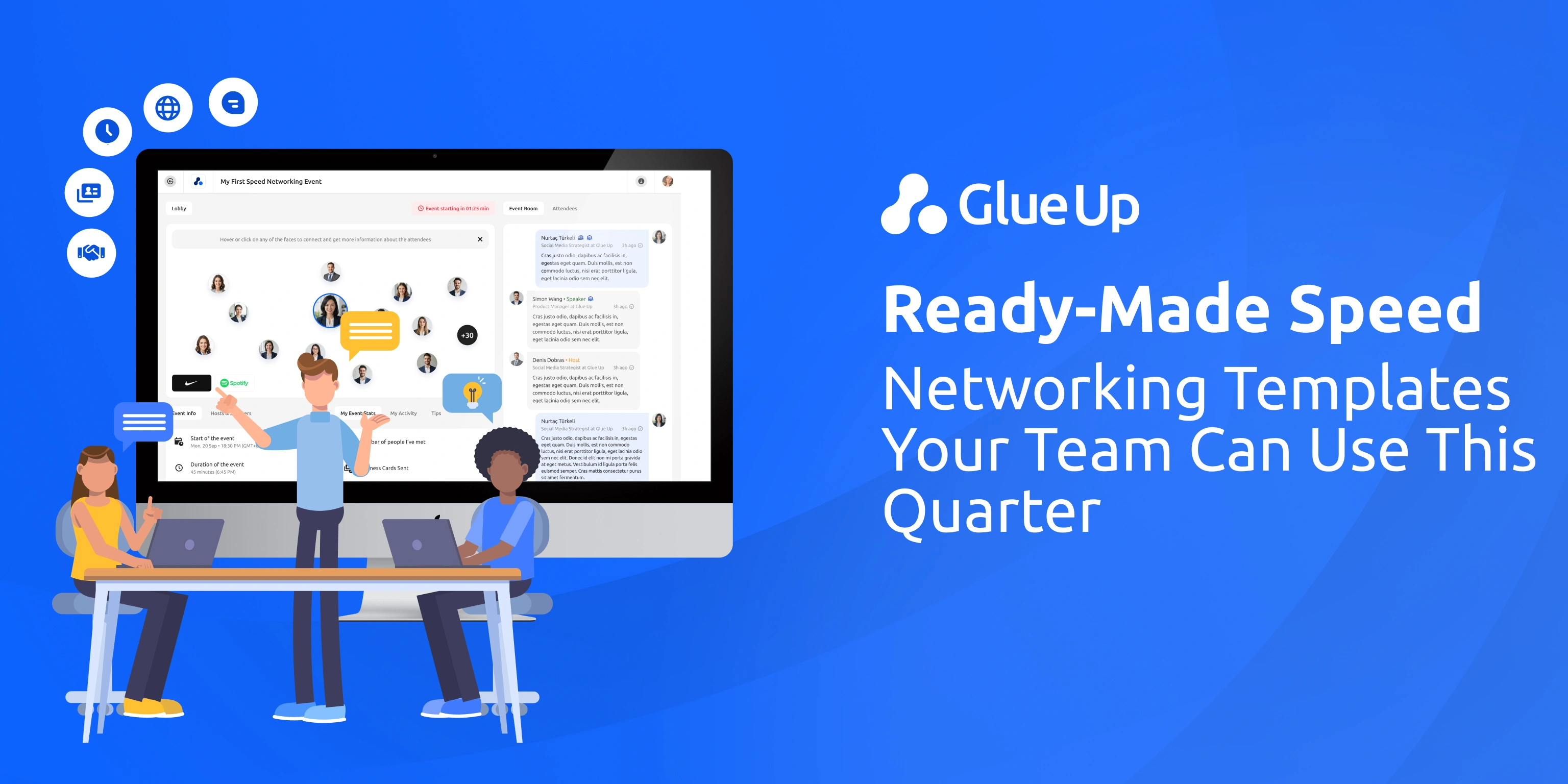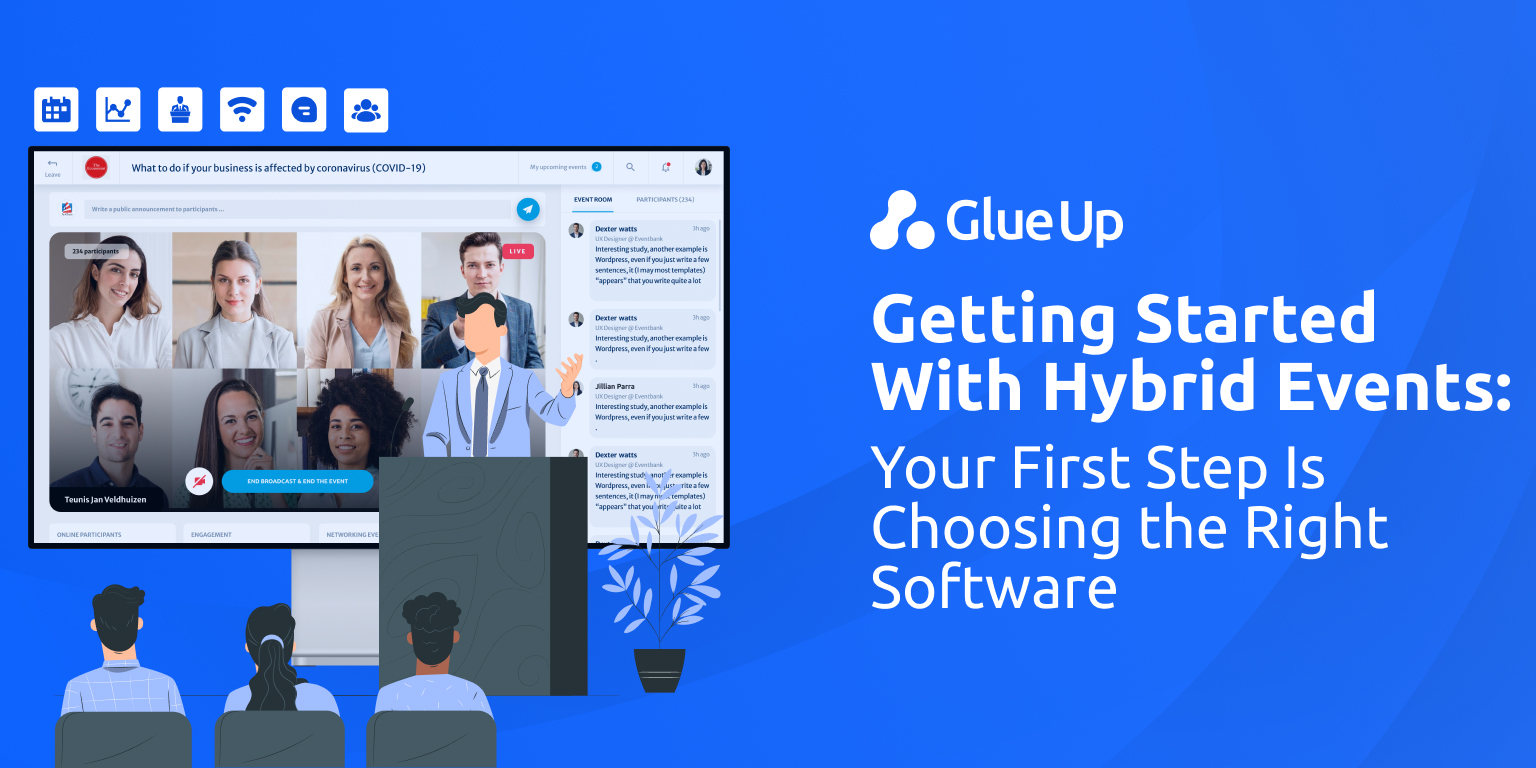
Running a speed networking event without a clear structure wastes time and misses connections. Teams often struggle with timing, participants lose focus, and the event loses momentum. Ready-made speed networking templates prevent all this by giving your association or chamber a tested framework for agendas, conversation flow, and participant movement.
In this post, we will explore how different speed networking templates work, why they matter for member organizations, and how Glue Up's speed networking software helps you deliver structured events that create measurable value.
We will also share practical examples of templates you can adapt this quarter to save time, improve consistency, and strengthen member engagement.
Need a Better Way to Run Networking Sessions? Use Glue Up's Speed Networking Software
Want to keep conversations on track, ensure the right matches, and collect useful data? Glue Up's speed networking software gives you automated matching, built-in timers, and CRM integration so every interaction is productive and measurable. Book a demo today and see how Glue Up turns networking into quantifiable results.
Key Takeaways
- Speed networking templates keep events organized, consistent, and outcome-focused.
- Different formats (agenda, rotation, question guides, checklists) fit different event goals and audiences.
- Templates prevent small talk by guiding members into purposeful conversations.
- Associations and chambers can scale these formats across chapters for consistency.
- Glue Up's speed networking software powers automation, matching, and data capture, making structured events easier to deliver.
Why Speed Networking Templates Matter for Associations and Chambers

Networking is one of the primary reasons people join associations. Research shows that 80% of professionals say networking is important to career success. When a speed networking event lacks structure, participants struggle to stay engaged, conversations lose focus, and members leave without meaningful connections.
Speed networking templates provide the structure that associations and chambers need. They outline timing, rotation, and guided prompts so every conversation stays purposeful. In a chamber's business mixer or an association's mentor matching program, templates create consistency and professionalism across events.
When paired with our all-in-one association management software, templates stop being a standalone tool and become part of a larger member engagement strategy. The platform connects networking events with your membership database, communications, and reporting so every introduction is tracked, every follow-up is automated, and every connection contributes to long-term retention.
Speed Networking Question Guide Templates for Associations and Chambers
Even the best-planned speed networking event can fall flat if conversations stay superficial. A structured question guide allows participants to skip small talk and focus on what matters.
Associations and chambers can tailor guides to specific audiences, whether it's members meeting for the first time, businesses looking for partnerships, or mentors guiding early-career professionals. Below are ready-to-use templates with sample questions and instructions for application:
Note: These are sample question templates. Feel free to edit and personalize as per your event.
General Member Networking Question Template
General networking sessions are often the first touchpoint for members. Without a guide, conversations risk becoming repetitive or transactional. A question guide ensures participants introduce themselves with purpose, identify shared interests quickly, and leave with contacts they will follow up on.
Sample Questions
- What motivated you to join [Association/Chamber], and how has it impacted your professional goals so far?
- Which member benefit have you used most recently, and what results did it bring?
- What project or initiative is your organization focusing on this quarter?
- How do you usually measure success in your role or business?
- Which type of partnership would make the biggest difference for you right now?
- What trend in our industry do you think will matter most over the next year, and why?
- When have you attended a networking event that really worked for you, and what made it valuable?
- What skills or resources are you hoping to develop through your membership?
- Who would you most like to meet in this room today, and how could they help you?
- What is one way another member could support your work immediately?
Instructions
- Provide participants with two questions per rotation to keep conversations structured.
- Rotate questions each round to avoid repetition.
- Encourage participants to capture one actionable takeaway after each meeting.
- Use these prompts in follow-up surveys to align event results with member expectations.
Chamber of Commerce Business Mixer Question Template
Business mixers are designed to create referrals, spark partnerships, and strengthen the local economy. Without structure, conversations can drift into surface-level introductions. A targeted question guide directs members toward practical outcomes that benefit both parties.
Sample Questions
- What products or services does your business provide that members may not know about?
- Who is your ideal customer, and how can other members help connect you?
- Which chamber program has delivered the most measurable value for your business?
- What local economic change has most influenced your business this year?
- Which industries or companies are you most eager to collaborate with in the next six months?
- What customer acquisition strategy has worked best for you recently?
- How does your company contribute to the community, and how can members support those efforts?
- What operational challenge are you working to solve right now?
- Which chamber connection has led to your most successful partnership?
- What could the chamber do to make networking events more valuable for businesses like yours?
Instructions
- Provide 2–3 questions per rotation based on the business profile of attendees.
- Encourage participants to exchange contact information tied to specific answers.
- Use a final "ask and offer" round, where businesses state one thing they need and one thing they can give.
Mentor-Mentee Networking Question Guide
Mentorship programs work best when conversations go beyond generic advice. A structured guide creates a space where mentors share real stories, and mentees ask questions that uncover practical insights.
Sample Questions
- What skill are you working to develop this year, and why is it important?
- Which milestone in your career shaped your path the most, and how did it happen?
- What is the most useful piece of advice you ever received from a mentor?
- What has been the biggest challenge in advancing your career, and how did you overcome it?
- Which resource, book, or tool has influenced your professional growth the most?
- Who has been the most influential figure in your career, and what did you learn from them?
- What professional risk did you take that changed your career trajectory?
- How do you balance long-term career goals with short-term responsibilities?
- What skill do you wish you had developed earlier in your career, and how would it have helped?
- Where do you see the biggest opportunities for young professionals in this field today?
Instructions
- Assign one question per round to keep sessions focused.
- Rotate mentees through mentors so they gather a wide range of perspectives.
- Encourage mentors to share personal stories tied to each question.
- Collect follow-up feedback to help identify ongoing mentor-mentee matches.
Leadership Roundtable Networking Question Template
Leadership sessions are most effective when they spark strategic conversations among executives, board members, or chapter leaders. A guide keeps the focus on decision-making, priorities, and lessons leaders can share with each other.
Sample Questions
- What is your chapter's top priority for the next 12 months, and why?
- How do you measure success for your chapter or organization?
- Which leadership challenge has been the hardest to navigate this year?
- What strategies have helped you increase member engagement?
- How do you manage limited resources while still delivering on member expectations?
- What has been your most successful advocacy or policy initiative?
- How do you identify and prepare future leaders in your chapter or association?
- What role does technology play in your decision-making today?
- What is one change you wish your chapter had implemented sooner?
- How do you balance local chapter needs with the goals of the national organization?
Instructions
- Provide leaders with one question per round to allow deeper reflection.
- Encourage note-taking for ideas that can be shared with their boards.
- Rotate leaders into different groups to diversify perspectives.
- Collect insights afterward to feed into strategic planning documents.
New Member Welcome Networking Question Template
New members often feel overwhelmed at their first event. A thoughtful question guide helps them open up, build confidence, and see immediate value in their membership.
Sample Questions
- What motivated you to join this association or chamber?
- What are you hoping to gain from your membership in the first year?
- Which type of member connection would be most valuable to you right now?
- What professional goals are you currently focused on?
- How did you first hear about this organization?
- What was your first impression when you joined, and what stood out?
- What is one challenge you are facing in your role or business?
- What upcoming event or program excites you the most?
- Who would you like to meet today, and why?
- What could the organization do to make your first year more successful?
Instructions
- Share questions on printed cards so new members feel guided.
- Pair newcomers with existing members who can answer questions as well as ask them.
- Rotate pairs every 3 minutes to maximize exposure.
- Gather feedback after the session to refine onboarding support.
Advocacy and Policy Networking Question Guide
When members meet to discuss advocacy or policy, questions should go beyond introductions and focus on legislative priorities, shared challenges, and opportunities for influence.
Sample Questions
- Which policy issue has the greatest impact on your work right now?
- What advocacy success has your organization achieved recently?
- Which legislative challenge do you believe we are not addressing enough?
- What outcome would you like to see from this year's policy agenda?
- How has your chapter engaged members in advocacy campaigns?
- What partnerships have helped your policy efforts succeed?
- How do you measure the effectiveness of your advocacy work?
- What policy win from another industry or region inspires you?
- What is one action you think our members should take in the next 6 months?
- How can chapters collaborate to make our policy voice stronger?
Instructions
- Assign policy topics to each round of conversations.
- Provide one guiding question per round to keep sessions structured.
- Document responses and share them with advocacy staff for follow-up.
- Use insights to shape talking points for future campaigns.
Virtual or Hybrid Networking Question Guide
Virtual events require concise, engaging prompts to prevent fatigue and ensure participants remain active in short breakout sessions.
Sample Questions
- What motivated you to join this virtual networking session?
- What has been your best experience with online collaboration so far?
- Which tools or platforms make virtual connections easiest for you?
- What challenges have you faced networking online?
- How does your organization approach building connections in a hybrid environment?
- What outcomes would make today's session most valuable for you?
- Who is the most interesting person you've met virtually, and why?
- How has remote work changed the way you build relationships?
- What kind of hybrid events do you find most effective?
- What is one way this association could make virtual networking stronger?
Instructions
- Pre-load one question into each breakout room for participants to see as they join.
- Keep rounds short (3 minutes) to maintain energy.
- Use Glue Up's speed networking software to automate rotations and capture matches.
- Encourage participants to follow up via LinkedIn or member directory.
Read More: Where Networking Works Best: Physical, Virtual, and Hybrid Models for 2025 and Beyond
International or Chapter Exchange Question Template
Cross-chapter networking helps members learn from different regions and contexts. Questions should highlight similarities, differences, and best practices.
Sample Questions
- What is the biggest opportunity in your region right now?
- Which local challenge has shaped your chapter's activities most this year?
- How do you engage members who are spread across a large geography?
- What event format works best in your region?
- Which cultural or economic trends most influence your chapter?
- How do you recruit and retain volunteers locally?
- What partnerships have made your chapter more effective?
- How do you share successes with your national or international office?
- What one initiative could another chapter replicate successfully?
- How do you balance local needs with global strategy?
Instructions
- Assign participants from different chapters to pair together each round.
- Use chapter-specific prompts to encourage sharing of best practices.
- Rotate pairs frequently so members gain exposure to diverse perspectives.
- Collect and publish key takeaways as a post-event resource.
Fundraising and Sponsorship Networking Question Template
Fundraising and sponsorship conversations succeed when they uncover motivations, align expectations, and connect values. A question guide keeps discussions focused on shared goals instead of vague sales pitches.
Sample Questions
- What inspired your company or organization to invest in sponsorships or philanthropy?
- Which outcomes matter most when you choose who to support?
- How do you measure the success of a partnership with an association or chamber?
- What past sponsorship brought you the strongest return, and why?
- How do you prefer to connect with members after a sponsored event?
- What type of visibility is most valuable for your brand?
- What is your company's biggest priority for community engagement this year?
- How do you decide which partnerships to continue long-term?
- What challenge do you face in connecting with target audiences, and how can we help?
- What kind of recognition would feel meaningful to your stakeholders?
Instructions
- Place sponsors at fixed tables, with participants rotating every 3 minutes.
- Provide one or two questions per round to guide discussions.
- Encourage sponsors to take notes for personalized follow-up.
- Collect sponsor feedback to refine packages and offerings.
Women in Leadership Networking Question Template
Networking spaces for women leaders should encourage sharing career journeys, breaking barriers, and building alliances. A structured guide ensures conversations stay authentic and empowering.
Sample Questions
- What has been your proudest leadership achievement so far?
- What barrier did you overcome that shaped your leadership style?
- How do you mentor or support other women in your profession?
- What advice would you give your younger self starting in leadership?
- How do you balance personal responsibilities with professional growth?
- Which leader has influenced your career the most, and what did you learn from them?
- What opportunities do you see emerging for women leaders today?
- What workplace policies or programs have made your career progression easier?
- How do you handle moments when your leadership is underestimated?
- What kind of support do you most value from your peers?
Instructions
- Assign small groups of 3–4 participants per rotation to create safe, open discussions.
- Provide prompts on table cards so conversations stay participant-led.
- Use one closing round for participants to share resources or mentorship offers.
Student and Young Professional Networking Question Template
Students and early-career members often struggle with introductions. A structured guide gives them confidence and ensures they leave with mentors, opportunities, and practical advice.
Sample Questions
- What motivated you to pursue your current career path?
- Which skills do you want to develop most in the next 2 years?
- What professional experience has been most valuable so far?
- Which event, course, or training has had the biggest impact on your learning?
- Who do you look up to in your industry, and why?
- What challenges do you face entering the workforce?
- What kind of mentor are you hoping to meet?
- What is one project or initiative you'd love to work on this year?
- How do you hope this association will support your career?
- What role do you see yourself in 5 years from now?
Instructions
- Pair students with seasoned professionals in each round.
- Use one question per rotation to keep sessions manageable.
- Encourage mentors to share concrete advice rather than generalities.
- Collect student feedback to improve mentorship programming.
Event Follow-Up Networking Question Guide
Post-event sessions help members solidify connections and reflect on what they learned. A structured guide ensures conversations move from "What did you think?" to "How will you apply it?"
Sample Questions
- What was your biggest takeaway from the event?
- Which session or speaker gave you the most actionable insight?
- What is one idea you plan to implement immediately?
- Which resource or tool mentioned at the event will you explore further?
- Who did you meet that you plan to follow up with, and why?
- How has this event changed the way you see your role or business?
- What was the most surprising thing you learned?
- Which speaker or panelist would you like to hear from again?
- How can the association support you in applying what you learned?
- What will success look like for you in the next 6 months because of this event?
Instructions
- Use a shorter rotation (2–3 minutes) since participants already share context.
- Assign one reflection question per round.
- Document responses for use in marketing materials or case studies.
Cross-Industry Exchange Networking Question Guide
Associations and chambers often bring together diverse industries. A focused guide helps members learn from perspectives outside their own sector.
Sample Questions
- What is the biggest challenge facing your industry today?
- Which innovation or trend is reshaping how you work?
- What is one practice from your field that others could adopt successfully?
- How do you see your industry contributing to the local economy?
- Which regulation or policy is most affecting your sector right now?
- What role does technology play in your day-to-day operations?
- What is the most exciting opportunity in your field this year?
- Which partnerships across industries have you found most valuable?
- What skill do you think professionals outside your industry could learn from yours?
- How could associations or chambers support cross-industry collaboration more effectively?
Instructions
- Mix participants from different industries at each table or breakout.
- Provide one question per round to highlight differences and common ground.
- Encourage participants to identify at least one cross-industry opportunity per session.
How Speed Networking Templates Strengthen Member Engagement
Speed networking templates do more than keep events on schedule. They turn quick introductions into conversations that lead to partnerships, mentorships, and long-term membership value. For associations and chambers, these guides are not just about structure, but about delivering consistency across every chapter and event.
Glue Up gives you the technology to take these templates further. With our speed networking software, you can automate participant matching, manage timing with built-in tools, and capture data directly into your CRM. The result is structured events that create measurable outcomes and stronger member relationships.
Book a demo today and see how Glue Up helps you deliver networking sessions that members will remember.
Frequently Asked Questions About Speed Networking Templates
How do speed networking templates improve member retention?
They ensure every participant leaves with valuable connections, which directly strengthen renewal decisions. Consistent, structured events prove that the association or chamber delivers on its promise of networking value.
Can smaller chapters use speed networking templates effectively?
Yes. Smaller chapters often benefit the most, since templates keep sessions efficient and prevent wasted time. Even a group of 10 can use structured agendas and rotation charts.
What should be included in a speed networking event checklist?
A solid checklist covers venue or platform setup, participant instructions, rotation timing, question prompts, and post-event follow-up. It ensures no logistical detail is missed.
How do digital speed networking templates work?
They are designed for virtual or hybrid events, using software to manage participant matching, breakout room rotations, and automatic time tracking. This reduces manual oversight and keeps online sessions engaging.
How often should associations or chambers run speed networking events?
Quarterly sessions are common, but frequency should align with member needs. High-demand industries may benefit from monthly networking rounds, while smaller groups may prefer semi-annual events tied to conferences.
Quick Reads
- Add-On Cart for Member Retention & Growth
- Simplify Multi-Currency Payment Posting for Community Chapters With Glue Up + Paygage
- AI Automation for Event Registration & Beyond
- Integrating AI into CRM for Membership Growth
- How to Build a Chapter Event Calendar
- What Is All-In-One Association Software?
- AI-Powered Member Check-In Software



